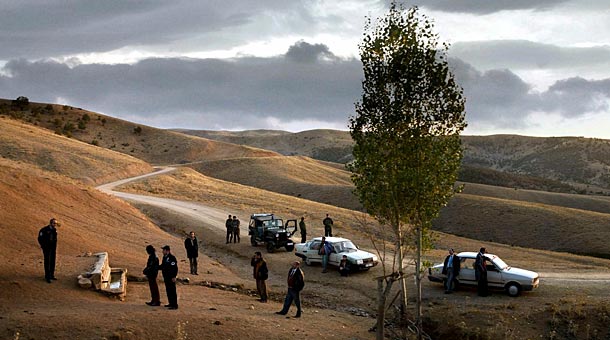
The film shows you everything but tells you nothing.

The film shows you everything but tells you nothing.
Never have I written so many notes for a film where so little happens than with Once Upon a Time in Anatolia. Mainly because I was struck over and over on how well shot the film is and how unique the experience felt. As I look at my notes right now, about 90% of them are on how strong the filmmaking is and how down-right beautiful it is for essentially its entire running time. Anatolia runs 153 minutes and it feels like it. It is a film that is never in a hurry to get anywhere.
Running at a slow and methodical pace, Anatolia moves like a turtle. But if we remember our fables, slow and steady wins the race. I have a feeling that most people will give up on the film after a half hour, but trust me, those who stick with it for its entire length will be rewarded immensely. It has many hidden surprises for the audience members that pay attention and see the film through.
Anatolia is bare bones in its plot but lush and sublime in its presentation. The film begins with three men drinking and watching TV. One of the men goes outside to check on his dog that is tied up. The film fades to black and when we come back we are in the Turkish countryside following a few cars as they cruise the road looking for a crime scene.
Out of the car steps a bunch of men. Some are cops, one of them a doctor, another a prosecutor and two of them are handcuffed. The two handcuffed men are two of the three men from the opening scene. So now we are curious. What exactly happened? Everything is explained throughout the two and a half hour plus run time. You just better be paying attention, because not everything is fully explained to you. Anatolia is a great show and tell game. The film shows you everything but tells you nothing. Part murder mystery, part road trip, part existentialistic discussion, Anatolia culls from all over to create an at times dream like trance.

I’ve pretty much described what happens for most of the runtime of the film, the discussion now moves to how freaking gorgeous and well shot the film is. We are talking about grade A cinematography here. Director Nuri Bilge Ceylan (who has a background in photography) works with his director of photography, Gokhan Tiryaki, to create shots that are utterly magical. Some of them would fit in well at the Louvre if you were to grab a screenshot of them.
One such shot involving an apple is a true work of art. The shot begins on an apple tree where the apple falls from. It hits the ground with a loud thud and rolls downhill into a small stream where it flows to its end where other apples sit. The shot lasts maybe a minute but is a stroke of genius. The entire shot is lit up by a car’s headlights. Its little things like this peppered throughout Anatolia that make the film so special.
What I loved about the film is that at times it just sits back and watches the characters interact with each other and their environment. It’s never in a hurry, which is nice. It lets the audience relax and get absorbed in the plot with high class filmmaking. There are multiple scenes where cops will take the accused off to a site to look for the body and the camera will stay back with two men waiting for them at the cars. The camera just stares at the back of their heads for 5 minutes as they talk about life and death. One might think this is boring, but it’s actually quite majestic.
Once Upon a Time in Anatolia won the Grand Prix at the Cannes Film Festival last year, which is basically the second place trophy which was fully deserved (the winner was The Tree of Life). It’s a deeply rewarding film that doesn’t give in to genre expectations and at times allows itself to just simply exist. If not appreciated for the presentation of its story which can be tedious and difficult to follow at times, it should be recognized for its rich filmmaking that is truly something to behold.